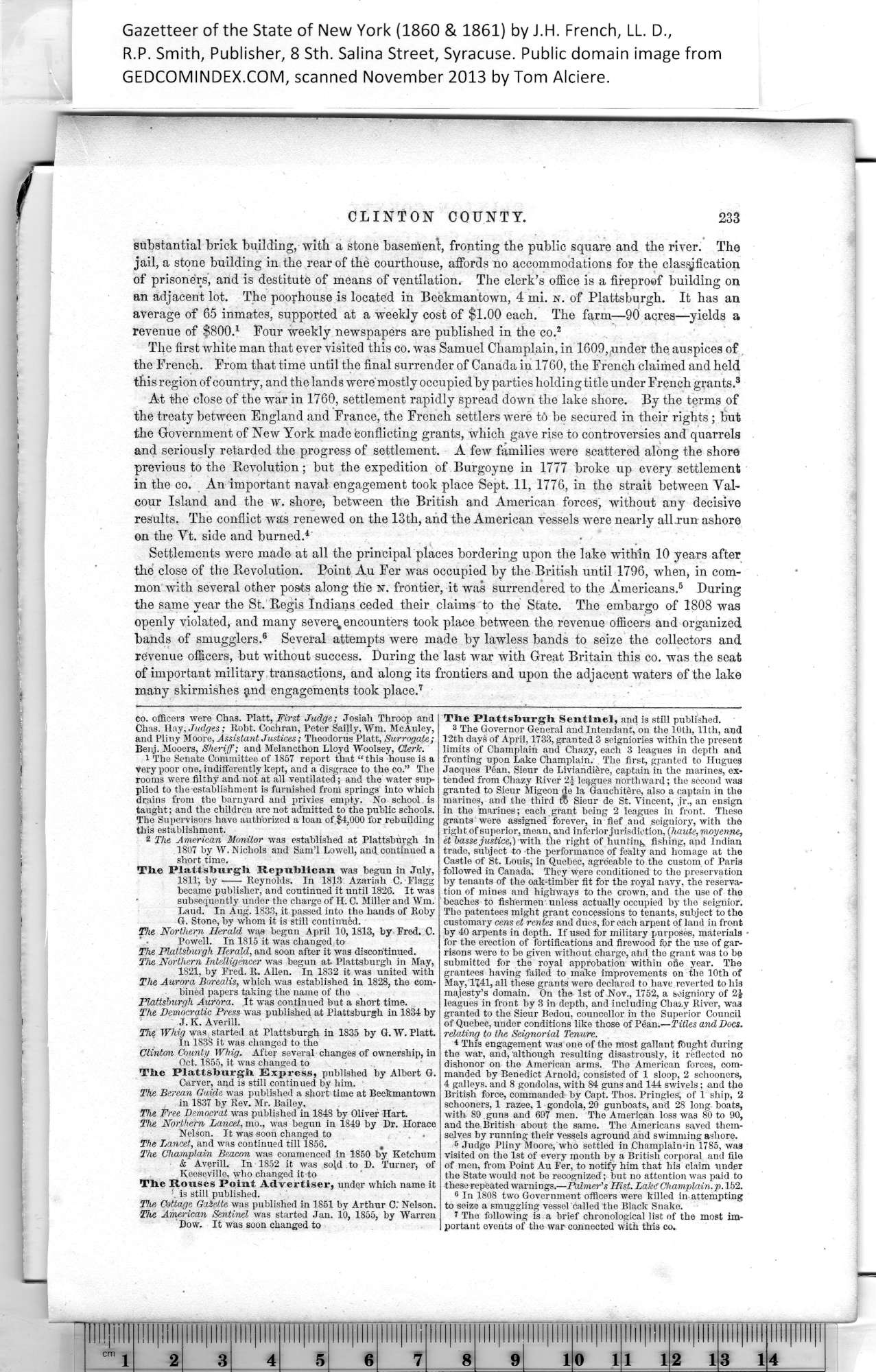|
co. officers were Chas. Platt, First Judge; Josiah Throop and
Chas. Ilay, Judges; Itobt. Cochran, Peter Sailly, Wm. McAuley,
and Pliny Moore, Assistant Justices; Theodorus Platt, Surrogate;
Benj. Mooers, Sheriff; and Melancthon Lloyd Woolsey, Clerk.
1 The Senate Committee of 1857 report that “this house is a
very poor one, indifferently kept, and a disgrace to the co.” The
rooms were filthy and not at all ventilated; and the water sup¬
plied to the establishment is furnished from springs into which
drains from the barnyard and privies empty. No school is
taught; and the children are not admitted to the public schools.
The Supervisors have authorized a loan of $4,000 for rebuilding
this establishment.
2 The American Monitor was established at Plattsburgh in
1807 by W. Nichols and SamT Lowell, and continued a
short time.
Tlie Plattsltmrgli Republican was begun in July,
1811, by Reynolds. In 1813 Azariah C. Flagg
became publisher, and continued it until 1826. It was
subsequently under the charge of H. C. Miller and Wm.
Laud. In Aug. 183-3, it passed into the hands of Roby
G. Stone, by whom it is still continued.
The Northern Herald was begun April 10,1813, by Fred. C.
Powell. In 1815 it was changed to
The Plattsburgh Herald, and soon after it was discontinued.
The Northern Intelligencer was begun at Plattsburgh in May,
1821, by Fred. R. Allen. In 1832 it was united with
The Aurora Borealis, which was established in 1828, the com¬
bined papers taking the name of the
Plattsburgh Aurora. .It was continued but a short time.
The Democratic Press was published at Plattsburgh in 1834 by
J. K. Averill.
The Whig was started at Plattsburgh in 1835 by G. W. Platt.
In 1838 it was changed to the
Clinton County Whig. After several changes of ownership, in
Oct. 1855, it was changed to
Tbe Plattsburgh Express, published by Albert G.
Carver, and is still continued by him.
The Berean Guide was published a short time at Beekmantown
in 1837 by Rev. Mr. Bailey.
The Free Democrat was published in 1848 by Oliver Hart.
The Northern Lancet, mo., was begun in 1849 by Dr. Horace
Nelson. It was soon changed to
The Lancet, and was continued till 1856. #
The Champlain Beacon was commenced in 1850 by Ketchum
& Averill. In 1852 it was sold to D. Turner, of
Keeseville, who changed it to
Tbe Rouses Point Advertiser, under which name it
is still published.
The Cottage Gaiette was published in 1851 by Arthur C.' Nelson.
The American Sentinel was started Jan. 10, 1855, by Warren
Dow. It was soon changed to |
Tbe Plattsburgh Sentinel, and is still published.
3 The Governor General and Intendant, on the 10th, 11th, and
12th days of April, 1733, granted 3 seigniories within the present
limits of Champlain and Chazy, each 3 leagues in depth and
fronting upon Lake Champlain. The first, granted to Hugues
Jacques Pean, Sieur de Liviandtere, captain in the marines, ex¬
tended from Chazy River 2| leagues northward; the second was
granted to Sieur Migeon de la Gauchittre, also a captain in the
marines, and the third t?> Sieur de St. Vincent, jr., an ensign
in the marines; each grant being 2 leagues in front. These
grants were assigned forever, in fief and seigniory, with the
right of superior, mean, and inferior jurisdiction, (haute, moyenne,
et hasse justice,) with the right of hunting fishing, and Indian
trade, subject to the performance of fealty and homage at the
Castle of St. Louis, in Quebec, agreeable to the custom of Paris
followed in Canada. They were conditioned to the preservation
by tenants of the oak-timber fit for the royal navy, the reserva¬
tion of mines and highways to the crown, and the use of the
beaches to fishermen unless actually occupied by the seignior.
The patentees might grant concessions to tenants, subject to tho
customary cens et rentes and dues, for each arpent of land in front
by 40 arpents in depth. If used for military purposes, materials
for tho erection of fortifications and firewood for the use of gar¬
risons were to be given without charge, and the grant was to be
submitted for the royal approbation within ofie year. The
grantees having failed to make improvements on the 10th of
May, 1741, all these grants were declared to have reverted to his
majesty’s domain. On the 1st of Nov., 1752, a seigniory of 2-|
leagues in front by 3 in depth, and including Cliazy River, wa3
granted to the Sieur Bedou, councellor in the Superior Council
of Quebec, under conditions like those of Pean.—Titles and Docs,
relating to the Seignorial Tenure.
* This engagement was one of the most gallant fought during
the war, and, although resulting disastrously, it reflected no
dishonor on the American arms. The American forces, com¬
manded by Benedict Arnold, consisted of 1 sloop, 2 schooners,
4 galleys, and 8 gondolas, with 84 guns and 144 swivels; and the
British force, commanded by Capt. Thos. Pringles, of 1 ship, 2
schooners, 1 razee, 1 gondola, 20 gunboats, and 28 long boats,
with 89 guns and 697 men. The American loss was 80 to 90,
and the British about the same. The Americans saved them¬
selves by running their Vessels aground and swimming ashore.
6 Judge Pliny Moore, who settled in Champlain-in 1785, was
visited on the 1st of every month by a British corporal and file
of men, from Point Au Fer, to notify him that his claim under
the State would not be recognized; but no attention was paid to
these repeated warnings.—Palmer’s Hist. Lake Champlain, p. 152.
6 In 1808 two Government officers were killed in attempting
to seize a smuggling vessel called the Black Snake.
I The following is a brief chronological list of the most im¬
portant events of the war connected with this co. |
